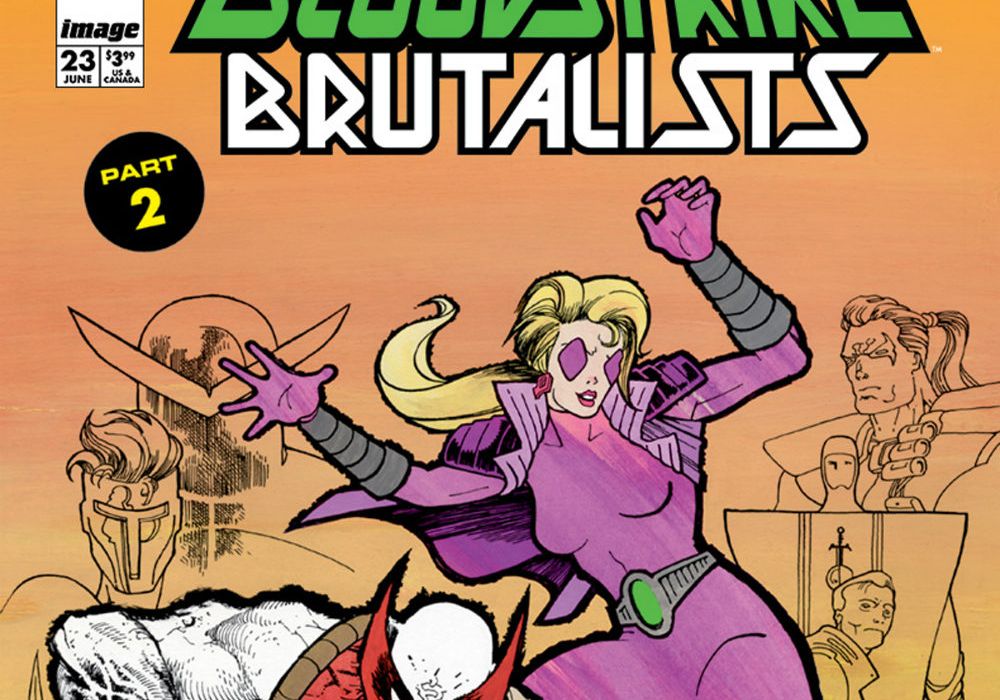Michel Fiffe continues his inimitable revival of “Bloodstrike” as Tag investigates a string of murders and Max searches to cure his bodily deterioration. Our review will contain minor spoilers.

Written, Illustrated, Colored, and Lettered by Michel Fiffe
“BRUTALISTS,” Part Two Bureaucratic overlords with morbid agendas need love, too. What lengths will they go to? A string of gruesome murders, a deadly disease, and a dark conspiracy; for Bloodstrike, that’s a Tuesday.
Michel Fiffe is an auteur. The Cuban-American comic book writer and artist (and colorist and letterer) brings his all-encompassing talents and unique style to resurrect this quintessentially excessive ’90s property. After releasing a “quasi-origin tale” in last issue’s #0, Fiffe continues the original numbering of “Bloodstrike” “on the never-released issues 23 and 24, in order to tie up loose ends from the first 22.” (Disclaimer: I’m not at all versed in the history and goings-on of Bloodstrike or Rob Liefeld’s creations, but I am a fan of Michel Fiffe from his excellent work on “Copra.”) Michel Fiffe proved to be an inspired choice for the bombastic super powered action of this resurrected superhero team, and #23 is another solid entry. After her minimal role in issue #0, Tag comes to the forefront in Brutalists Part Two ‘Tag, You’re It!’
Plot may not be the strong suit of “Bloodstrike: Brutalists” (and certainly won’t be the selling point for those unfamiliar with the series). As much as Fiffe’s three-issue run wants to be a standalone story, prior familiarity with the Bloodstrike crew will certainly help here. Concentrating on a handful of characters does help narrow the focus to the immediate concerns of a select few, and sidelines the regular team’s affairs to the periphery. #23 mostly strays away from superhero action. Instead, it turns into a tale of body horror, as Max suffers the cataclysmic effects of a one-night stand with Tag, and Tag’s own investigation leads down a dark corridor of gruesome mutilations. Fiffe also riffs on bureaucratic ineptitude and immorality during Tag’s detective work. Her efforts are utterly worthless against the corrupt machine of Project: Born Again. Even the victims are cost-effectively disposed of via portal dump. Despite serving up Erik on a silver platter, the powers that be aren’t free from red tape.
Michel Fiffe’s dynamic page layouts crackle with energy and motion. Violent encounters pull us in close, allowing us to experience the gritty reality and ferocity of mortal struggles: pained expressions, abject fear, and the super-close up of a decaying eye before it sees its last sight. It’s brutal and vicious and Fiffe makes you feel the whole bloody affair. In another scene, a man named Erik leads Tag into the basement of Dents Noire, and a single illustration is split into three panels, breaking it down into three separate beats. It’s an attempted chloroforming (colored sickly green), before Tag freezes her would-be captor (colored triumphant pink). The next page uses similar paneling to great effect once more. Super close-ups of the facial orifices of Tag, Erik, and Erik’s victims slow the pace down, allowing readers to fully absorb the horror before pulling out to reveal the room in full. Fiffe routinely likes to reduce aspects of character into simple geometric shapes, as if testing his own limits of graphic deconstruction: Tag’s pink diamond eyes, black circles of empty eye sockets, or the mandible-like logo of Dents Noires. Fiffe utilizes a similar technique with color, often breaking down panels into its essential hues, while the background fades into neutral beige. Tag herself, is represented chromatically as pink, indicated by her diamond eyes and the bubblegum gutters every time she appears on page.
Too many of today’s modern comics feature word balloons that clash too harshly with the underlying artwork. Having the same artist and letterer on a single title really helps to achieve cohesion between the two. Or perhaps it’s that Fiffe’s lettering is written by hand in defiance of the digital lettering of today’s comics. Fiffe’s off-kilter typeface and ballooning suit his idiosyncratic style. He also cleverly changes Max’s word balloons to match his altered state. Max’s word balloons fracture as he speaks, breaking down just like his body. It’s the sort of bold, experimental ambition that fans of Fiffe will expect but still appreciate.
Ultimately, the issue is a complete success from a visual standpoint. Michel Fiffe does what he does best in a style that respects the original Rob Liefeld and Dan Fraga work without sacrificing his own style. Besides the plot hiccups (or just my general confusion based on “Bloodstrike” ignorance), the long-awaited #23 will certainly please fans of Fiffe and “Copra”—though I can’t pretend to know how true “Bloodstrike” fans will react.
Final Verdict: 7.9 – Michel Fiffe’s off-kilter style remains the selling point on his second issue of “Bloodstrike: Brutalists.”



